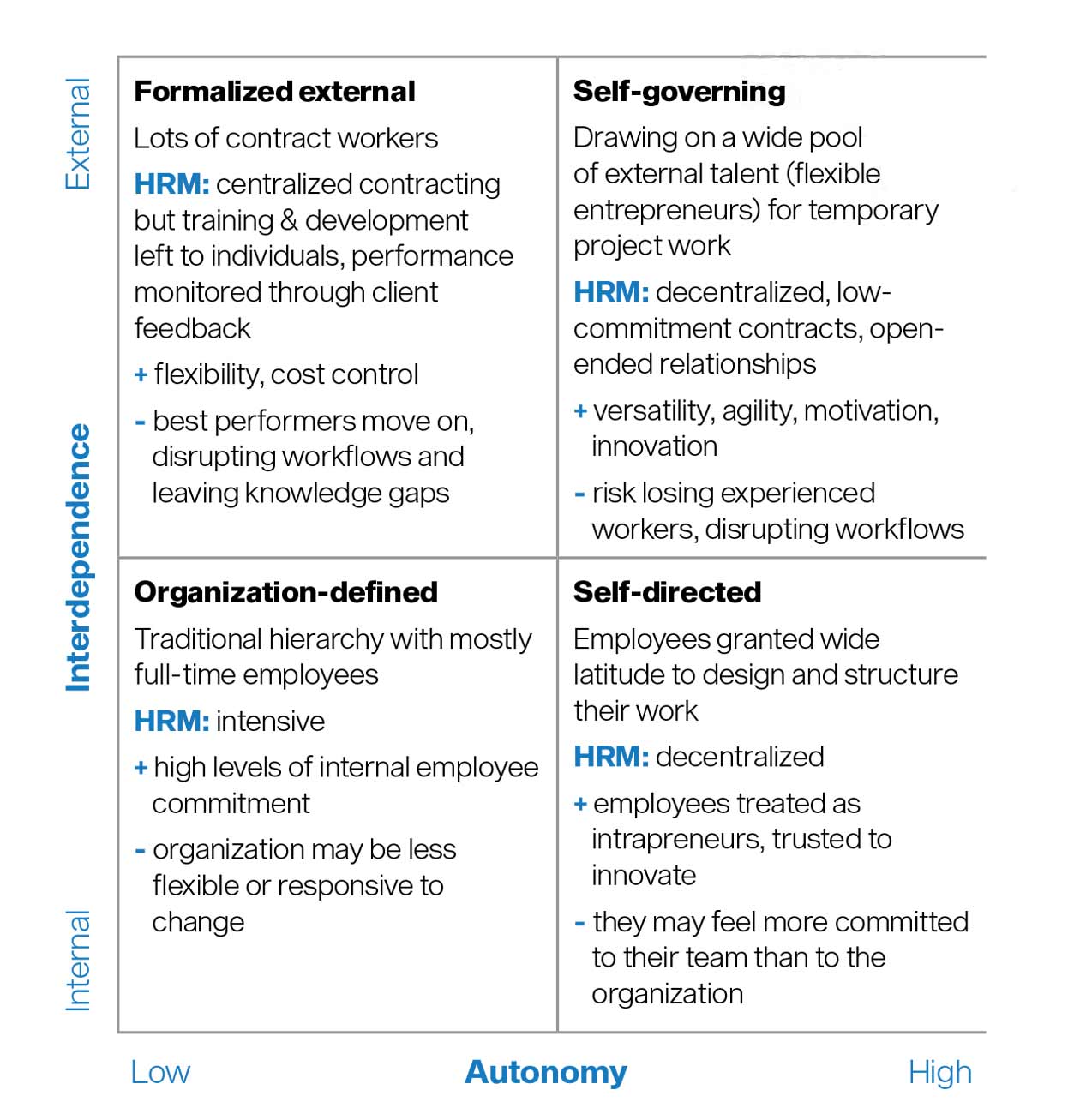
IESE Insight
Work design: What kind of workforce do you need?
Adapt to changing times through strategic use of work design.
Our world of work is changing — fast. To stay competitive and attract, retain and utilize talent, management teams need to rethink traditional ways of working.
Moreover, in the digitally driven, post-pandemic ecosystem, what works for one company won’t necessarily work for others. Stable workforce or agile freelancers? Central decision-making or autonomous employees? Clearly, the needs of an appliance manufacturer differ drastically from the needs of, say, Uber.
An award-winning paper by IESE Prof. B. Sebastian Reiche considers how work design — the content and organization of work tasks, relationships and responsibilities — has resisted adapting to these changes, and how effective work design can be key for managers and human resource teams to help future-proof their organizations.
This paper is the winner of the 2023 Best Paper Award from Human Resource Management Journal.
Why work design matters
The use of external vs. internal workers, and of top-down vs. worker-led models, can have ramifications for a company’s identity and performance. Reiche examines two core aspects of work design, and then breaks them down further.
First, there is work interdependence — the extent to which work roles depend on interaction with external or internal workers.
The second factor is work autonomy — the amount of freedom workers are given to make decisions around their own tasks, including their content and interface with other workers.
This research examines four possible configurations of these factors. At a time of increased innovation in possible ways of working, awareness and planning can help managers determine how best to shape organizational work structures.
Four types of work design
Each of Reiche’s four configurations of work design has distinct ramifications for HR and for the company. How is your organization deployed? Might the pros and cons of another configuration dovetail better with your firm’s aims?
1. Organization-defined
Traditional hierarchical organizations with primarily full-time workers. External contractors are used only occasionally, and work autonomy is relatively low due to a top-down approach to allocating and monitoring tasks.
Among other factors, this work design structure requires intensive human resource management to define and align work roles and activities.
Advantage: This model encourages high levels of internal employee commitment.
Disadvantage: Difficult to extend to interactions with externals, and the organization may be less flexible and responsive to change.
2. Autonomous staff
Like organization-defined design, this model is used by companies whose workers are mostly full-time, internal employees. However, these companies seek to decentralize management authority and give workers higher levels of freedom.
Reiche looks at an in-depth case study in the Haier Group, a Chinese multinational home appliance firm. The Haier system is unique: the company is subdivided into independent microenterprises along the company’s internal value chain. These units have high levels of autonomy to make strategic decisions, recruit and deploy staff from the internal talent market, and distribute profits.
In relation to HR, hiring processes and reward structures tend to be decentralized, though HR and management can remain involved. Since roles and responsibilities often change, formalized training is often prioritized less than learning on the job. Performance evaluations usually involve managers and HR staff, but peer feedback is also important.
Advantage: Employees are often seen as “intrapreneurs” who are trusted to innovate and who feel strong ownership of their work.
Disadvantage: There’s a danger that workers become more committed to their team than they are to the organization as a whole.
3. Formalized but externalized
Organizations who rely heavily on external freelancers or contractors but have a centralized structure for how work tasks are done.
Digital platforms like Uber fall into this category, as do professional service providers like Ambar Partners, an on-demand law firm whose lawyers are independent workers. The freelance workers decide how, when and where they work — but the company screens applications, provides a predefined pricing structure, and monitors projects.
HR for this model typically involves centralized hiring decisions, repeated contracting of the same worker pool, rapid onboarding, and little training and development, which is left to individual workers. Performance is monitored either through surveillance or direct customer feedback.
Advantage: Potential to reduce costs and boost flexibility and innovation while retaining control over some aspects of talent management.
Disadvantage: The risk of losing strong performers to better opportunities, which can affect workflow and leave knowledge gaps.
4. Self-governing
These organizations draw on a wide pool of external, flexible workers and take a decentralized approach to shaping work tasks and roles. Workers often act as a company of one: they have significant autonomy in planning and performing their work, and deciding how to engage with other workers. Employment contracts are often open and low-commitment, and performance feedback is received directly from peers and clients.
New York music ensemble Snarky Puppy uses a self-governing way of working. The composition of the group changes continually, as members switch between roles and choose which projects they will participate in. Project network organizations and temporary film production or event organization teams also often work this way.
Advantage: Highly versatile and agile. Workers are motivated to upskill and expand their roles, and innovation is high.
Disadvantage: As before, organizations risk losing experienced workers and destabilizing the workflow.
As work requirements and tasks continue to evolve due to both technological change and worker demands, managers can use work design strategically to optimize how things are done. HR, too, will have to think strategically as new forms of work design will likely continue to emerge and adapt.

About the research
This research reviews work design theory to date in order to outline a new typology of different work design modes and their respective relationships with human resource management (HRM). It uses three in-depth case studies to illustrate this typology, drawing on a wide range of online sources, previous case studies, interviews, and academic publications for each organization studied.

